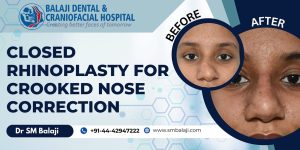The patient’s facial deformities from fracture reduction after a road accident
A patient is a young man employed in the UAE. He got involved in a road traffic accident a little over three years ago. This resulted in fractures to the facial bones on the right side. It also included a floor of the orbit blowout fracture. The patient was first treated as an emergency at the time of the accident. This left him with residual deformities from the fracture correction surgery. The patient developed diplopia and enophthalmos as a result of the surgical correction.
The patient presents for consultation with Dr. S M Balaji
The patient had been searching far and wide for the right surgeon to correct the deformities. He was then referred to Dr. S M Balaji, Cranio-Maxillofacial Surgeon by an oral surgeon in the UAE. The patient first contacted the hospital manager at our hospital. She requested the patient to mail all pertinent medical records to the hospital. Dr Balaji studied the medical records in depth including all imaging studies. He informed the patient that his facial deformities could be set right. The patient presented at Balaji Dental and Craniofacial Hospital’s Trauma care unit. All preoperative investigations were then performed. The surgery was then scheduled for the patient.
Successful surgical correction of the patient’s fracture
Under general anesthesia, a maxillary vestibular incision was first made. The site of the zygomatic fracture repair on the right side was then accessed. The plates from the previous surgery were then removed and the area refractured with a drill.
An incision was next made extending from the outer canthus of the right eye. The plate from the previous surgery was then removed and the area refractured. This was next followed by a transconjunctival incision. The site of the orbital floor fracture repair was then accessed. All refractured segments were next brought into proper alignment. A Titanium mesh with Medpor coating was then shaped to align with the floor of the orbit.
This was then placed on the floor of the orbit and screwed to the lower orbital wall. Transconjunctival incision was then closed with sutures. Refractured segments of the zygomatic bone were then replated and the incision sutured. The outer canthal incision was then closed with sutures. The patient recovered without an event from general anesthesia.
The patient returns back to the UAE
The patient expressed complete satisfaction at the time of discharge from the hospital. There were no noticeable facial scars from the surgical procedure. He was very happy with the results of the surgery.





